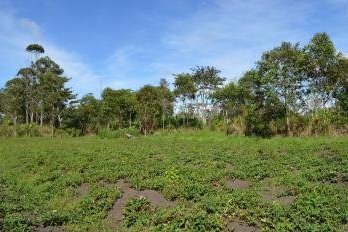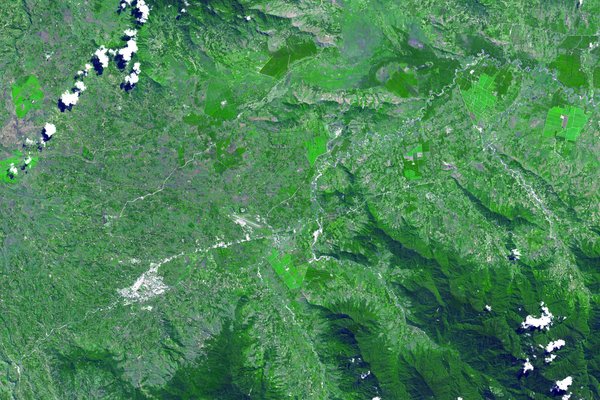Papua New Guinea
Kuk
Kuk Early Agricultural Site represents the earliest evidence of the independent transformation towards the domestication of plants in Oceania.
The site covers 116ha of swamp land systematically cultivated since 7,000 and possibly 10,000 years ago. Crops grown include taro, yams and bananas. Stone tools have been found, as well as ditches and drainage channels used to drain the wetland.
Community Perspective: located a short drive outside Mount Hagen, but to the casual visitor, similar to most of the agricultural areas surrounding that city; one wonders if it is really “seeable”. Michael provided some practical tips (“The value-to-cost ratio of my visit to Kuk was probably the lowest of any of the WHS that I have visited”), and more are in this Forum Post. We also have a ‘review’ by one of the archaeologists who worked on the site in 1977.
Site Info
Official Information
- Full Name
- Kuk Early Agricultural Site (ID: 887)
- Country
- Papua New Guinea
- Status
-
Inscribed 2008
Site history
History of Kuk
- 2008: Inscribed
- Inscribed
- 1999: Deferred
- Bureau - Needs new Management plan and better visitor handling facilities etc
- Type
- Cultural
- Criteria
- iii
- iv
Links
- UNESCO
- whc.unesco.org
- Related
-
- world-archaeology.com — World Archeology on findings in Kuk
- stewartstrathern.pitt.edu — Story of the Kuk UNESCO World Heritage Prehistoric Site and The Melpa. Includes a photo of the WHS plaque on page 29.
All Links
UNESCO.org
- whc.unesco.org — whc.unesco.org/
Related Resources
- world-archaeology.com — World Archeology on findings in Kuk
- stewartstrathern.pitt.edu — Story of the Kuk UNESCO World Heritage Prehistoric Site and The Melpa. Includes a photo of the WHS plaque on page 29.
News Article
- Feb. 28, 2019 looppng.com — K100,000 for Kuk World Heritage Site
Community Information
- Community Category
- Human activity: Agriculture
- Cultural Landscape: Relict
Travel Information
One thousand visitors or fewer
Recent Connections
-
One thousand visitors or fewer
DD: "Current visitation is negligable" … -
Swamps and Marshes
"The Kuk swamp is now part of an extens… -
First inscriptions
Papua New Guinea (2008)
Connections of Kuk
- Geography
-
-
Melanesia
-
Situated in one of the SIDS
Papua New Guinea 2008
-
- Trivia
-
-
Customary ownership
The Papua New Guinea authorities abandoned the Research Station about 15 years after independence in 1975, and the site was then reoccupied by its local customary owners, the Kawelka clan (AB ev)
-
- Ecology
-
-
Peat
"The remains of former agricultural practices are mostly buried and preserved underneath deposits that have accumulated in the wetland through ...... in situ peat accumulation" and "comparison of the records and finds from archaeological excavations in the 1970s (following drainage) and in the late 1990s (25 years after drainage for the Station), indicate that only the upper peat layer that accumulated in the last 100 years has been severely degraded" (Nom File) -
Swamps and Marshes
"The Kuk swamp is now part of an extensive area of intensively cultivated wetland in several densely populated valleys" (AB ev)
-
- World Heritage Process
-
-
First sites filling gaps cited by ICOMOS
non Australian cultural sites of the Pacific 2008
-
First inscriptions
Papua New Guinea (2008) -
Only WHS in their country
Papua New Guinea -
Slow Starters
1997-2008 : 11 years
-
- Human Activity
-
-
Irrigation and drainage
-
Tea
The site has been used for growing tea. AB review In "the late 1960s ... the landscape was drained and converted into a tea plantation"
-
- Timeline
- Science and Technology
-
-
Innovations in Agriculture
"It contains well-preserved archaeological remains demonstrating the technological leap which transformed plant exploitation to agriculture around 6,500 years ago. It is an excellent example of transformation of agricultural practices over time, from cultivation mounds to draining the wetlands through the digging of ditches with wooden tools. Kuk is one of the few places in the world where archaeological evidence suggests independent agricultural development and changes in agricultural practice over such a long period of time." (UNESCO)
-
- Visiting conditions
-
-
One thousand visitors or fewer
DD: "Current visitation is negligable" (Periodic Reporting 2012)
-
News
- looppng.com 02/28/2019
- K100,000 for Kuk World Heritage Si…
Community Reviews
Show full reviews
In July 2016, I spent a few days in Mount Hagen, where I stayed at the Highlander Hotel. Mount Hagen is a short drive from the Kuk Early Agricultural Site, Papua New Guinea's only World Heritage Site, which demonstrates a technological leap that transformed plant exploitation to agriculture around 7,000 to 6,400 years ago, based on vegetative propagation of bananas, taro and yam. Kuk, however, is probably only interesting to agricultural historians and wasn't that interesting to a more casual visitor; in fact, the core area, at least to me, was indistinguishable from the buffer zone, which looked similar to most of the agricultural areas surrounding Mount Hagen. Prospective visitors should contact Nicholas Namba (email: nnamba77 (at) gmail.com), who acts in some type of official capacity and has lived at the site since the early Australian excavations; he's very familiar with the site and was, in fact, the first guide that I've had at any WHS to point out the core area as distinct from the buffer zone. It would be difficult, if not impossible, to rely on the WHS map to identify the core area, so a visitor should seek guidance from Mr. Namba. Perhaps the most surprising thing about my visit to Kuk was that the weather app on my iPhone recognized that I was at Kuk Agricultural Site.
Papau New Guinea is best known for its avifauna, so my main objective was to see at least one species of bird-of-paradise in the wild. I went …
Keep reading 0 comments
In 1977, it was my great good fortune to be part of professor Jack Golson's multi-disciplinary team during the field season at Kuk Station. My husband, Art Rohn (North American anthropologist/prehistorian) and myself (cartographer) were visiting Australia for a year's sabbatical where we became friends with Jack Golson and faculty members at Australia National University and Sydney University.
I left cartography and archaeology years ago to pursue other interests. But Kuk left such an indelible stamp on me that for years I searched the Internet for mentions of the site. There were only a few papers on Kuk, one citing our work there. However, since Kuk's inclusion as a World Heritage Site in 2008, all manner of Kuk publications abound.
Kuk remains one of the most happy and vibrant memories in a life thus far liberally sprinkled with adventure. Imagine how exciting it was for a young woman of 34 to contribute to what would become one of the most important continuously cultivated agrarian sites in the world. I remember vividly how my husband at the time, Art Rohn, offered his vast expertise to help interpret what Kuk was all about.
The excavations, of course, were paramount to this multi-disciplinary interpretation. At first I used the previous mapping techniques, increasingly aware of their inability to represent sometimes amorphous features without diffinitive boundaries. One evening we sat around the dinner table, in one of the 2 stilt houses we called camp, hashing over better ways to map the mounds and valleys …
Keep reading 0 comments
If Kuk does get inscribed in 2008 it will be another case of a “near miss” for us I am afraid! We may well have flown over it when we took a light plane along the Waghi valley from Goroka to Mt Hagen (the site is a short distance NE of Mt Hagen airfield) but I wouldn’t claim that as “seen”! However, I wonder if it is really “seeable” by anyone other than archaeologists connected with the government or university research.
But we did achieve some “connection” with the site as we visited the JK McCarthy Museum in Goroka (This is the main "Highland Museum"). Its exterior is painted with a mural (Photo) depicting the early agriculturalists of the area (described in the museum as the “world’s first gardeners” or similar words! PNG is clearly, and rightly, proud of this historical development by its peoples). A section of the museum was devoted to the discovery at Kuk Swamp (which is situated further west near the town of Mt Hagen) of the remains of these early agricultural practices. Excavations have identified plant residues, stone implements and indications of ditch/mound building which show that, as long ago as 10000 years BP, there had been “agriculture” in the area based initially on taro and then, around 6500 years BP, involving bananas, sugar cane and yams. The dates are very significant because they indicate that these people in the Highlands of PNG were not recipients of the knowledge and skills for sedentary agricultural practices …
Keep reading 0 comments
